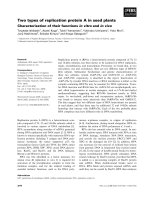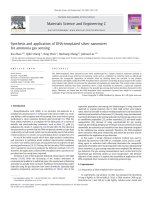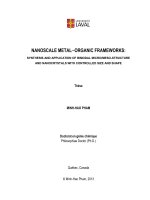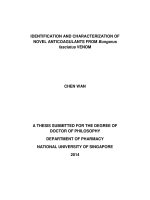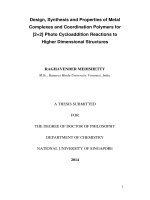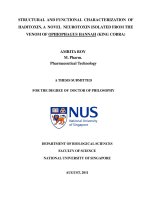Synthesis and characterization of novel jacketed polymers and investigation of their self assembly and application 5
Bạn đang xem bản rút gọn của tài liệu. Xem và tải ngay bản đầy đủ của tài liệu tại đây (324.37 KB, 19 trang )
Chapter 5
Synthesis and characterization of novel polymer used
as fluorescent label
138
5.1 Introduction
In the integrated circuit (IC) fabrication industry, the demand for pushing to finer
features appears to be intense and it is necessary to develop new technologies. Several
lithographic pathways to reduce feature size are under continuous development
1
.
Except for the control of critical dimension pattern of sub-100 nm, pattern-placement
metrology also plays a critical role in the nanofabrication. The patterning of mask
requires strict fidelity and placement accuracy. The accuracy of the pattern placement
is widely recognized as a major hurdle in developing sub-100 nm technologies. A
successful lithographic technology must control mask distortions, alignment and other
sources of overlay errors to less than 20% of the critical dimensions
2-4
. Such precision
is not achieved with traditional e-beam lithography due to the difficulty in monitoring
the electron beam on the substrate directly. As the feature size decreases, the
contribution of the electron-beam patterning step towards the errors in the mask-
making process become larger due to many reasons, which include the stage accuracy,
substrate heating and long term drifts. All such cumulative effects become substantial
in the final output
5
. Spatial-phase-locked electron-beam lithography (SPLEBL) is
being developed to significantly improve the pattern-placement accuracy. Currently,
SPLEBL is the only known solution for achieving a sub-20 nm pattern-placement
accuracy
4-13
. A critical component in the SPLEBL technique is the fiducial grid,
which is patterned on a substrate and provides a direct reference for the position of e-
beam. As the e-beam scans the substrate writing patterns, a weak interaction between
the substrate and the grid generates a periodic signal, which gives information about
the e-beam position on the substrate. Accordingly, the e-beam’s position can be
locked on to the spatial phase of the fiducial grid in a feed back scheme.
7
Good
improvement of the pattern-placement precision is reported using scintillating global-
139
fiducial grid and through the membrane signal monitoring method
2, 3, 10 - 13
. However,
the observed signal-to-noise ratio is poor.
One of the schemes proposed to avoid the problems in focusing e-beam, is to lay
down Smith’s fiducial grids as a feedback system. To avoid the poor signal-to-noise
ratio, the grids are formed by adding fluorescent labels
14-16
to the resist film and an
optical signal with high contrast is generated using an electron-beam activation. A
successful fluorescent label should be highly sensitive to e-beam and significant
fluorescent contrast would be generated between exposed and unexposed area. UV-
active materials obtained considerable interest in the last two decades especially in the
area of photoresist materials
2
. The light-induced changes of photo-physical properties
of polymeric materials generate a good contrast between exposed and unexposed
areas and may be suitable for generating a fiducial grid signal.
Among the various photoactive systems, anthracene derivatives attracted significant
interest in the past. Paul et al.
17-19
incorporated anthracene groups onto a polymer
backbone and used the polymer as potential photoimageble materials.
The
arrangement and the high concentration of the chromophores on the polymer
backbone gave good excimer fluorescence intensity upon excitation. Other aromatic
chromophores immobilized polymers are also developed as potential fluorescence
labels
20, 21
. Here we report the synthesis and characterization of novel chromophore-
incorporated polymers to enhance the chromophore density in the resist medium
without losing the processability. In this approach, we incorporated two
chromophores per each monomeric unit on a methacrylate polymer backbone and
used them as e-beam active fluorescent labels for e-beam writing applications. This
simple concept also allows us to prevent the crystallization or microphase separation
140
of chromophores inside the polymer film. The polymers are also tested as potential
fluorescent label dispersed in polymethyl methacrylate (PMMA) matrix.
5.2 Experimental section
5.2.1 Materials and reagents
All reagents were obtained from commercial companies such as Sigma Aldrich, Fluka
and used without further purification unless noted otherwise. Tetrahydrofuran (THF)
was dried over metallic sodium and distilled under nitrogen. N,N-dimethylformamide
(DMF) was dried with calcined 4 Å molecular sieves (Aldrich). Flash column
chromatography was performed using silica gel (60-120 mesh, Aldrich).
5.2.2 Instrumentation
Fourier transform infrared (FT-IR) spectra were obtained using a Perkin-Elmer 1616
FT-IR spectrometer as KBr discs.
1
H NMR,
13
C NMR spectra were recorded on a
Bruker ACF 300 MHz spectrometer. Thermal properties of the polymers were
investigated using thermogravimetric analysis (TGA) and differential scanning
calorimetry (DSC) on a TA-SDT2960 and a TA-DSC 2920 at a heating rate of 10 °C
min
-1
under nitrogen
environment. Gel permeation chromatography (GPC) were
conducted with a Waters 2696 separation module equipped with a Water 410
differential refractometer HPLC system and Waters Styragel HR 4E columns using
THF as eluent and polystyrene as standard. UV and fluorescence spectra were
performed on a HP 8452A spectrophotometer and SHIMDZU RF 500
spectrofluorophotometer. The contrast of optical signal was realized on a Zeiss laser
scanning confocal microscope. The excitation laser with a wavelength of 488 nm was
used. The optical band-pass filter before the photomultiplier tube on the microscope
was from 510 nm to 565 nm.
141
5.2.2 Synthesis
Poly(1, 3-bis(1-naphthyloxy)-2-propylmethacrylate) (3a), poly(1, 3-bis(4-
biphenyloxy)-2-propylmethacrylate) (3b), and poly(1, 3-bis(9-phenanthryloxy)-2-
propylmethacrylate) (3c) were synthesized starting from the commercially available
1,3- dibromo-2-hydroxypropane, as shown in Scheme 5.1.
Scheme 5.1. Synthetic scheme for the monomers and polymers.
General procedure for the synthesis of 1, 3-bisaryloxy-2-propanol (1)
To a 250 ml three-neck round bottom flask fitted with a reflux condenser, addition
funnel and a nitrogen inlet, 100 ml DMF, 50 mmol of the appropriate phenol and
potassium carbonate (10.4 g, 100 mmol) were added. The mixture was stirred at 80 °C
for 1 hr under nitrogen atmosphere. A solution of 1,3-dibromo-2-propanol (2.4 ml,
142
23.4 mmol) in 25 ml DMF was added dropwise using a dropping funnel. The reaction
mixture was stirred at 80 °C for 12 hr and filtered. The volatile components were
removed under reduced pressure and excessive phenol was extracted with 2M sodium
hydroxide solution followed by water (3 × 100 ml). The resulting crude product was
purified using column chromatography on a silica gel column with hexane and
dichloromethane (10:1) as the eluent.
1, 3-bis(1-naphthyloxy)-2-propanol (1a): Yield: 3.2g (41 %).
1
H NMR (300 MHz,
CDCl
3
, δ ppm) 8.3-7.8, (m, ArH, 4 H), 7.5-6.9 (m, ArH, 10 H), 4.7 (m, J = 5.2Hz, C-
CH(O)-, 1 H), 4.5 (d, J = 5.5 Hz, O-CH
2
-, 4 H), 2.7 (s, -OH, 1 H).
13
CNMR (75.4
MHz, CDCl
3
, δ ppm) 154.2, 137.2, 134.7, 127.7, 126.7, 126.0, 125.7, 125.5, 121.0,
105.3 (ArC), 69.4 (O-CH-), 69.2 (-O-CH
2
-). Anal. calcd for C
23
H
20
O
3
: C, 80.23 %; H,
5.81 %. Found: C, 80.61 %; H, 5.82 %.
1, 3-bis(4-biphenyloxy)-2-propanol (1b): Yield 5.6 g (61 %).
1
H NMR (300MHz,
CDCl
3
, δ ppm) 7.29-7.57 (m, ArH, 14 H). 7.03 (d, ArH, 4 H), 4.45 (m, C-CH(O)-C, 1
H), 4.23 (m, O-CH
2
-R, 4 H), 2.58 (s, -OH, 1 H).
13
CNMR (75.4 MHz, CDCl
3,
δ ppm)
157, 140, 134.4, 130.8, 128.7, 128.2, 126.7, 114.8 (ArC), 75.4 (O-CH), 68 (-O-CH
2
-).
Anal. calcd for C
27
H
24
O
3
: C, 81.79 %; H, 6.10 %. Found: C, 81.53 %; H, 6.18 %.
1,3-bis(9-phenanthryloxy)-2-propanol (1c): Yield: 3.6 g (35 %).
1
H NMR (300
MHz, DMSO-d
6
, δ ppm) 8.6-7.1 (m, ArH, 18 H), 5.7 (d, J = 5.14 Hz, -OH, 1 H), 4.6
(m, R-CH(O)-R,1 H), 4.5 (d, J = 4.8Hz, O-CH
2
-R, 4 H).
13
C NMR (75.4 MHz,
DMSO-d
6
, δ ppm) 157, 137.5, 135.7, 132.6, 132.4, 132.2, 130.9, 130.8, 129.6, 128.8,
127.8, 127.7, 127.4, 108.1 (ArC), 74.5 (O-CH-), 72.6 (-O-CH
2
-). Anal. calcd for
C
31
H
24
O
3
: C, 83.78 %; H, 5.41 %. Found: C, 83.65 %; H, 5.61 %.
143
General procedure for the synthesis of 1, 3-bisaryloxy-2-propyl methacrylate (2)
Triethylamine (3 ml, 22 mmol) and the appropriate 1, 3-bisaryloxy-2-propanol (1) (10
mmol) were dissolved in 50 ml dry THF placed in a 100 ml round-bottom flask. This
solution was cooled to 0 °C, and methacryloyl chloride (2 ml, 20 mmol) dissolved in
4 ml THF was added. The reaction mixture was warmed to room temperature, stirred
for 4 h, filtered and the volatile components were removed under reduced pressure.
The resulting crude product was dissolved in 25 ml dichloromethane, and washed
with sodium bicarbonate solution (50 ml), followed by water (3 × 50 ml). The organic
layer was dried over anhydrous magnesium sulfate, filtered and the excess solvent
was removed under reduced pressure to yield the monomer (2)
1, 3-bis(1-naphthyloxy)-2-propylmethacrylate (2a). Yield: 3.2 g (83 %).
1
H NMR
(300MHz, CDCl
3
, δ ppm) 8.3 - 6.9 (m, ArH, 14 H), 6.2 (s, CH
2
=C, 1 H), 5.6 (s,
CH
2
=C, 1 H), 5.9 (m, -CH(O)-R, 1 H), 4.6 (m, O-CH
2
-C, 4 H,), 2.0 (s, -CH
3
, 3 H).
13
C NMR (75.4 MHz, CDCl
3
, δ ppm) 166.5 (C=O), 146, 137, 135.5, 134.4, 127.7,
126.4, 126.2, 126.0, 125.6, 124.9, 122.0, 117.7 (ArC, C=C), 70.2 (O-CH-), 66 (O-
CH
2
-), 18.2 (-CH
3
). Anal. calcd for C
27
H
24
O
4
: C, 78.64 %; H, 5.83 %. Found: C,
78.96 %; H, 5.97 %.
1, 3-bis(4-biphenyloxy)–2-propylmethacrylate (2b). Yield: 3.0 g, (64 %).
1
H NMR
(300 MHz, CDCl
3
, δ ppm) 7.30 - 7.58 (m, ArH, 14 H), 7.03 (d, ArH, 4 H), 6.19 (s,
CH
2
=C-, 1H), 5.62 (m, -CH(O)-R, C=CH, 2 H), 4.38 (d, O-CH
2
-, 4 H), 1.99 (s, -CH
3
,
3 H).
13
C NMR (75.4 MHz, CDCl
3
, δ ppm) 166.5 (C=O), 146, 140.6, 135.8, 134.4,
128.7, 128.1, 127.7, 126.7, 126.0, 117.7 (ArC, C=C), 70.7 (O-CH-), 66.2 (O-CH
2
-),
18.2 (-CH
3
). Anal Calcd for C
31
H
28
O
4:
C, 80.17 %; H, 6.03 %. Found: C, 80.17 %; H,
6.26 %.
144
1, 3-bis(9-phenanthryloxy)–2-propylmethacrylate (2c). Yield: 1.7 g (65 %).
1
H
NMR (300 MHz, CDCl
3
, δ ppm) 8.3 – 7.1 (m, ArH, 18 H), 6.3 (s, C=CH
2
, 1 H), 5.6
(s, C=CH
2
, 1 H), 6.0 (m, -CH(O)-R, 1 H), 4.7 (m, J = 4.8 Hz, O-CH
2
-, 4 H,), 2.0 (s, -
CH
3
, 3 H).
13
C NMR (75.4 MHz, CDCl
3
, δ ppm) 166.6 (C=O), 151, 137, 132, 131,
127,126.9, 126.4, 126.2, 126.1, 124.2, 124, 122.2, 121.1, 102.9 (ArC, C=C), 70.5 (O-
CH-), 66.5 (O-CH
2
-), 17.9 (-CH
3
). Anal. calcd for C
35
H
28
O
4
: C, 82.03%; H, 5.47%.
Found: C, 82.45 %; H, 5.71 %.
General procedure for the preparation of poly (1, 3-bis(aryloxy)-2-propyl
methacrylate) (3)
The appropriate monomer 2 (2 mmol) and 2, 2’-azobisisobutyronitrile (AIBN) (0.02
g, 0.01 mmol, 0.5 mol %) were dissolved in 20 ml dry THF. The solution was
thoroughly degassed and flushed with nitrogen for 30 minutes, heated to 70 - 80 °C
and stirred for 18 hr under nitrogen atmosphere. The polymer 3 was isolated by
precipitation from methanol.
Poly(1,3-bis(1-naphthyloxy)-2-propylmethacrylate) (3a). Yield: 0.79 g (powder, 91
%).
1
H NMR (300 MHz, CDCl
3
, δ ppm) 8.353-7.08 (b, ArH, 14 H), 6.06 (b, -CH(O)-
R, 1 H), 4.17 (b, -CH
2
-O, 4 H), 2.01 (b, -CH
2
-, 2 H), 1.26 (b, -CH
3,
3 H). FT-IR
(KBr, cm
-1
): 3054
(ArH stretching), 2931 (-CH
2
- stretching), 1731 (ester C=O
stretching), 1580, 1509, 1460 (Ar, C=C stretching), 1268, 1156, 1020 (C-O-C
stretching).
Poly(1, 3-bis(4-biphenyloxy)-2-propylmethacrylate) (3b). Yield 0.72 g (powder, 79
%).
1
H NMR (300 MHz, CDCl
3
, δ ppm) 7.6 – 6.5 (b, ArH, 18 H), 4.4 – 3.6 (b, O-
CH
2
,
5 H), 2.3 - 1.7 (b, -CH
2
-, 2H), 1.4 - 0.9 (b, -CH
3
, 3 H). FT-IR (KBr, cm
-1
): 3029
(ArH stretching), 2930 (-CH
2
- stretching), 1729 (ester C=O stretching),
1602,1527,1486 (Ar, C=C stretching), 1240, 1174, 1047(C-O-C stretching).
145
Poly(1, 3-bis(9-phenanthryloxy)-2-propylmethacrylate) (3c). Yield: 0.8 g (powder,
75%).
1
H NMR (300 MHz, CDCl
3
, δ ppm) 8.1 - 7.0 (b, ArH, 18 H), 6.36 (b, -CH(O)-,
2 H), 3.95 (b, -CH
2
-O, 4 H), 1.87 (b, -CH
2
-, 2 H), 1.0 (b, -CH
3
, 3 H). FT-IR (KBr,
cm
-1
): 3067 (ArH stretching), 2920 (-CH
2
- stretching), 1724 (ester C=O stretching),
1626, 1602, 1527 (Ar, C=C stretching), 1268, 1150, 1020 (C-O-C stretching). 5.2.4
Molecular weight measurement
The molecular weights of polymer 3a, 3b and 3c were determined using GPC with
solutions of polymers in THF (table5.1).
Table 5.1. Number average (M
n
), weight average (M
w
) molecular weight and
polydispersity (PD) of polymers
Polymer M
n
M
w
PD
3a
0.60 × 10
4
1.71 × 10
4
2.9
3b
0.81 × 10
4
2.26 × 10
4
2.7
3c
0.51 × 10
4
1.16 × 10
4
2.2
5.2.3 Techniques and methods for re-structuring by high-energy electrons
The re-structuring process was carried out by irradiating the polymer film with a
beam of high-energy electrons using a predesigned pattern. The irradiation of
electron-beam is similar to an electron-beam direct writing step for the fabrication of
a mask in the IC industry. The beam writer is a JEOL JBX-5DII using LaB
6
as its
filament. The accelerating voltage for the electrons was 25 kV. 0.5 µm lines with an
interline spacing of 2 µm were made using an e-beam with a dosage of 300 µC/cm
2
.
The polymer film was deposited on a silicon wafer via spin-coating a homogenous
mixture of polymers 3 (25 wt % of the PMMA solid), PMMA (5 wt %) in
chlorobenzene, 2, 2’-p-phenylenebis-(5-phenyloxazole) (POPOP) (5 wt % of the
146
solid). Generally the POPOP was added as a wavelength shifter to reduce the
absorption of the scintillated photon by the polymer host, PMMA.
5.3 Results and Discussion
Methacrylate monomers carrying two chromophores were synthesized in moderate to
high yield using a simple synthetic strategy as shown in Scheme 5. 1. Highly soluble
polymers with high chromophore density along the polymer backbone were obtained
through free radical polymerization and fully characterized using spectroscopic
techniques.
5.3.1 Thermal properties
The thermal stability of the novel polymers in nitrogen was evaluated using
thermogravimetric analysis (TGA). All polymers showed a weight loss at 350-355 °C
at a heating rate of 10
°C /min above which the polymer start to degrade completely
100 200 300 400 500 600
0
20
40
60
80
100
3c
3b
3a
Weight percent (%)
Temperature (
o
C)
Figure 5.1. TGA traces of polymer 3a, 3b and 3c measured in nitrogen atmosphere
147
The thermal properties of all polymers were also analyzed by differential scanning
calroimetry (DSC) at a heating rate of 10
°C /min (Figure 5.2). A glass transition (T
g
)
was observed at about 80
°C for polymer 3a, but no melting point was observed. The
DSC plots of polymer 3b, and 3c showed corresponding T
g
at 85
°C and 112
°C,
respectively. However, polymer 3c showed a higher T
g
than the other two polymers,
which might be due to the presence of rigid and bulky pendant groups.
50 100 150 200
3c
3b
3a
T
g
112
o
C
T
g
85
o
C
T
g
80
o
C
Heat Flow (mW)
Temperature (
o
C)
Figure 5.2. DSC traces of polymer 3a, 3b and 3c measured in a nitrogen atmosphere.
5.3.2 Optical properties
The spectroscopic properties of polymers 3a, 3b and 3c were measured in chloroform
solution. The absorption and emission spectra of the polymers are shown in Fig.5.3
and the values as given in Table 5.2. The UV spectrum of polymer 3a showed
absorption maximum at 256 nm with a weak absorption at 308 nm. When excited at
256 nm, polymer 3a showed two strong emission peaks at 362nm and 379nm.
Polymer 3b exhibits the absorption maximum at 266 nm. When excited at 266 nm,
polymer 3b displayed emission peaks at 333nm. The spectrum of polymer 3c shows
148
maximum absorption at 258 nm with a shoulder around 298 nm. When excited at 258
nm, it displayed two strong emission peaks at 340 and 357nm. All polymers showed
fluorescence active around 330-390 nm. These can be ascribed to the attached
chromophore groups.
300 400 500
3c
3b
3a
Intensity (a.u.)
emission
absorption
wavelength (nm)
Figure 5.3. UV-vis absorption and Fluorescence spectra of polymers measured in
chloroform at room temperature
Table 5.2 The detailed data of UV-vis absorption and Fluorescence spectra polymer
3a, 3b and 3c
Polymer
λ
abso
(nm) λ
emiss
(nm)
3a
256, 308 362, 379
3b
266 333
3c
258, 298 340, 357
149
Polymers incorporated with biphenyl (3a), naphthyl (3b) to phenanthryl (3c)
chromophore group, a red shift on the fluorescence spectrum were observed. Other
photophysical properties of the polymers are currently under investigation.
5.3.3 The fiducial-grid signal
The enhancement of pattern placement accuracy in a SPLEBL scheme depends upon
the fidelity of the grid, the grid’s period and the quality of the periodic signal from the
grid. However, the contrast of the fiducial grid patterns is low due to the inherent
nature of interferometric lithography, which utilizes interference of two UV standing
waves (wavelength of 351 nm). In order to maintain the requirement of maskless
approach, the fiducial grid is patterned by e-beam, which generates high image
contrast at the exposure level. The signal from the grid is in the form of laser-
stimulating fluorescence and can be detected by a photomultiplier tube. The
preliminary experiment on the effect of electron excitation was carried out using the
polymers 3 film under a conventional JEOL SEM. The results are shown in Figure
5.4. Poly(methyl methacrylate)(PMMA) and its derivatives have been used as e-beam
resists
11-12
. Generally, the host polymer itself is not a good fluorescent active matrix
and hence the presence of an UV-active additive is necessary to pattern fiducial grid.
The final mixture of PMMA resist constitutes three components: (i) the host polymer,
(ii) the added chromophore and (iii) the wavelength shifter. Owing to the poor
solubility, the chromophores or fluorophores such as anthracene tend to crystallize
and precipitate out of the resist film and show a heterogeneous distribution. Here we
use the chromophore-immobilized polymers to prevent the heterogeneous distribution
of the chromophores and to obtain a high contrast for the pattern.
From fluorescence spectra of the pure polymers in solution as well as in thin film,
little fluorescence emission was observed between 515-565 nm (Table 5.2). This is
150
important to avoid the emission from the background. After irradiation by e-beam, a
bright green fluorescent line appeared at the exposed area (Figure 5.4). It is believed
that the interaction of e-beam with the chromophore on the film is primarily
responsible for such emission. Paul et al. described the mechanism of chemical
changes in anthracene-containing materials after UV exposure
17, 22
. Hence we believe
that the high-energy e-beam interacts with the substrate, and causes the
depolymerization of PMMA. However, the chromophors incorporated on each repeat
units remain on the substrate and produce a strong emission signal. The exact
mechanism of this emission is still under investigation. Our results indicate that both
polymers (3a and 3b) are active under e-beam irradiation and may be useful as a
fluorescence label in the e-beam writing.
A well-designed pattern was
generated onto the polymer film with different
chromophoric groups by using an electron-beam direct write method, which is a
standard step in mask fabrication. Figure 5.5 shows two typical fluorescence images
of the resist surface after patterned with an e-beam. A set of green 0.5 µm lines can be
resolved clearly with a spacing of 2 µm using an irradiation dosage of 300 µC/cm
2
.
The contrast between exposed and unexposed area is sufficient to give the image of
the pattern. However, polymer 3c appeared weak e-beam reactive matrix under the
experimental conditions used here. A dosage of 5 µC/cm
2
did not print any lines and
there was no image contrast between exposed and unexposed area. It is generally
believed that the host polymer is highly absorptive and hence a wavelength shifter,
POPOP, is added to increase the scintillation efficiency.
151
a
b
Figure 5.4. The fluorescence image of (a) pure 3a and (b) pure 3b after excitation by
electron beam of 13 kV voltage (the magnification of the picture is only 100 times).
a
b
Figure 5.5. The fluorescence image of a set of 0.5 µm lines, patterned by 25 kV e-
beam excitation and dosage of 300 µC/cm
2
, of the fluorescent PMMA resist mixture.
The mixture contains < 0.4 wt % POPOP and 25wt % various chromophore (a) 3a
(b) 3b
5.3.4 Sensitivity of the chromophore
The effect of the concentration of chromophore-immobilized polymers on the image
contrast was investigated. The results are shown in Figure 5.6. Anthracene is
dissolved in PMMA matrix to set a benchmark for reviewing the performance of the
152
synthesized polymers 3. The results showed that with the increase of the chromophore
concentration, more irradiation dosage is necessary so that the contrast between
exposed and unexposed area is sufficient to give a clear fluorescent image of the
patterns. Compared with anthracene, the sensitivity of chromophore-containing
polymers 3 is lower, and high irradiation dosage was required to generate strong
fluorescence. However, anthracene was precipitated and crystallized in the PMMA
matrix and created defects in the patterns in our experiments.
0 20406080100
0
200
400
Anthrance
3b
3a
Exposure dose (C/cm)
Loading of chromphore (wt%)
Figure 5.6. The effect of the concentration of chromophoric polymers on sensitivity
of the photo resists
The good solubility and lack of crystallization of the chromophore-immobilized
polymers 3a and 3b in the resist film allowed them to be potential candidates as
fluorescent labels in e-beam writing. Even though, the reported polymers need high
dosage for patterning, the images obtained were intense with high contrast. Since
there are many chromophores available, we believe that the performance can be
153
optimized via immobilization of other chromophores on the polymer backbone in the
near future.
5.4 Conclusion
A series of chromophore-immobilized polymethacrylate 3 were synthesized via
radical polymerization and tested them as potential fluorescent labels for e-beam
writing. The chromophore groups such as naphthyl, biphenyl and phenathryl groups
were incorporated on the polymethacrylate backbone and demonstrated the potential
of using these polymers for increasing the pattern placement accuracy of an e-beam
writer. The fluorescent label can be pre-irradiated to form the fiducial grids, which
would be used for getting the feedback of the electron beam position on the patterning
area. This scheme is believed to be capable of improving the placement accuracy over
the conventional registration marks that are outside of the patterning area.
References
1. Cerrina, F. J. Phys. D: Appl. Phys. 2000, 33, R103-R116.
2. Marrian, C.R.; Perkins, F.K.; McCathy, D. and Bass, R. Appl. Phys. Lett.
1996, 68, 678-683.
3. Perkins, F.K.; Marrian, C.R. and Peckerar, M. C. J. Vac. Sci. Technol. B
1998, 16, 3567-3571.
4. Schattenburg, M. L.; Chen, C.; Everett, P. N. and Smith, H. I. J. Vac. Sci.
Technol. B 1999, 17, 2692-2697.
5. Hastings, J. T.; Zhang, F.; Finlayson, J. G.; Goodberlet, J.G. and Smith, H. J.
Vac. Sci. Technol. B 2000, 18, 3268-3271.
6. Puisto, D. M.; Lawliss, M. S.; Rocque, J. M. and Hartley, J. G. J. Vac. Sci.
Technol. B 1996, 14, 4341-4349.
154
7. Smith, H. I.; Hector, S. D.; Aderson, E. H. J. Vac. Sci. Technol. B 1991, 9,
2992-3001.
8. Ferrera, J.; Wong, V. V.; Rishton, R. V.; Anderson, E. H.; Kern, D.P. and
Smith, H. I. J. Vac. Sci. Technol. B 1993, 11, 2342-2350.
9. Wong, V. V.; Ferrera, J.; Damask, J. N.; Carter, J.M.; Moon, E. E.; Hans, H.
A.; Smith, H. I. and Rishton, S. J. Vac. Sci. Technol. B 1994, 12, 3741-3749.
10. Wong, V. V.; Ferrera, J.; Damask J.; Murphy, E.; Smith, H. I. and Hans, H.
J. Vac. Sci. Technol. B 1995, 13, 2859-2864.
11. Googbertlet, J.; Ferrera, J.; Smith, H. I. J. Vac. Sci. Technol. B 1997, 15,
2993-2997.
12. Goodberlet, J.; Carter, J. and Smith H. I. J. Vac. Sci. and Technol. B, 1998,
16, 3672-3676.
13. Hastings, J. T.; Zhang, F.; Goodberlet, J.G. and Smith, H. Microelectron
Eng. 2000, 53, 361-367.
14. Akcakir, H. J.; Belomin, N.; Barry, N.; Muller, J. D.; Gratton, E. and
Neyfeh, M. Appl. Phy. Lett. 2000, 76, 1857-1859.
15. Zhao, J. J.; Bae, S.; Xie, Feng and Granick, S. Macromolecules 2001, 34,
3123-3126.
16. Talhavini, M.; Atvars, T.; Schurr, O. and Weiss, R. Polymer 1998, 39, 3221-
3232.
17. Paul, S.; Stein, S. and Mullen, K. Acta Polymer 1996, 46, 67-73.
18. Paul, S.; Stein, S.; Knoll, W. and Mullen, K. Acta Polymer 1994, 45, 235-
243.
19. Paul, S.; Halle, Olaf ; Mullen, K. Thin Solid Films 1996, 288, 150-154.
155
20. Itoh, Y.; Inoue, M.; Kusano, S. and Goshima, T. European Polymer Journal
2001, 37, 411-416.
21. Itoh, Y.; Inoue, M.; European Polymer Journal 2000, 36, 2605-2610.
22. Kawashima, Y.; Hashimoto, T.; Nakano, H. and Hira, K. Theor. Chem. Acc.
1999, 102, 49-64.
156
